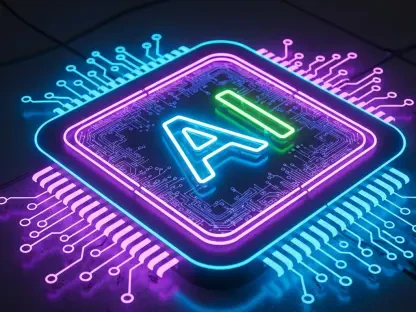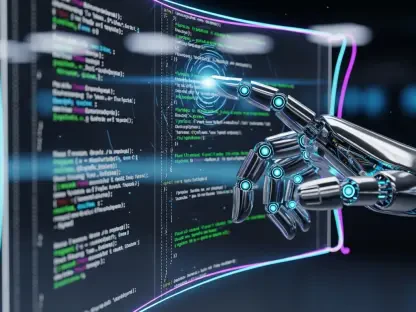Technology is pushing the boundaries of cybersecurity with AI at its forefront, reshaping how vulnerabilities are identified and mitigated. Fuzzing, an automated testing technique, plays a crucial role in uncovering software vulnerabilities. As AI gains traction in addressing fuzzing-related bugs, the potential for revolutionizing cybersecurity practices is immense. This article explores AI’s capacity to transform the process of fixing bugs uncovered by fuzzing, presenting exciting possibilities for the future of digital security.
The Power of Fuzzing in Cybersecurity
Unveiling Software Vulnerabilities
Fuzzing stands as a cornerstone in cybersecurity, leveraging random input generation to expose software vulnerabilities hidden within complex code structures. Its systematic approach effectively identifies issues like memory corruption and parsing errors, which often evade traditional testing methods. As software becomes increasingly complex, fuzzing provides an essential shield against potential threats by revealing weaknesses that could be exploited by malicious actors. The relentless evolution of digital environments demands robust protection mechanisms, and fuzzing’s role in this arena is indisputable.
The technique’s efficacy lies in its ability to automate the detection process, significantly accelerating the identification of vulnerabilities compared to manual methods. By simulating numerous permutations of input data, fuzzing sheds light on potential flaws which, if unaddressed, could lead to severe security breaches. This automated probing capability ensures that software can be continually improved and fortified without the exhaustive burden of manual testing, offering a level of precision and efficiency that is increasingly crucial as threats evolve.
Challenges in Manual Debugging
Despite fuzzing’s prowess in pinpointing vulnerabilities, manually debugging and resolving these issues presents significant challenges. The process demands meticulous attention to detail and extensive expertise, often requiring considerable time and resources. Each vulnerability uncovered necessitates an intricate examination to ascertain the root cause, demanding a level of scrutiny that is both exhaustive and painstaking. In a cybersecurity environment characterized by constant change, the burden of manual debugging can strain resources, delaying crucial updates and leaving systems exposed.
This labor-intensive approach often becomes a bottleneck in rapidly addressing vulnerabilities, potentially hindering timely mitigation efforts. The intricacies of complex software necessitate a thorough understanding, often leading to prolonged debugging sessions that consume valuable operational bandwidth. The need for specialized expertise exacerbates these challenges, as it adds layers of complexity to the debugging process. As cybersecurity continues to evolve, overcoming these hurdles becomes imperative to ensure prompt and robust protection against vulnerabilities exposed by fuzzing techniques.
Introduction to AutoPatchBench
Bridging Academic and Industry Gaps
AutoPatchBench emerges as a vital benchmark specifically designed to address the lack of standardized measures for AI-driven security fixes, particularly concerning fuzzing-identified vulnerabilities. This initiative fills a significant void within academic and industrial circles, providing a framework to objectively evaluate the effectiveness of AI program repair systems. By harmonizing efforts between researchers and practitioners, AutoPatchBench underscores the importance of collaboration in advancing cybersecurity solutions. Its launch signifies a pivotal moment in the integration of AI technologies with cybersecurity practices, offering a pathway to refine automated repair capabilities.
This benchmark represents a critical stride in innovation, enabling scholarly and commercial entities to align their methodologies in tackling fuzzing-related bugs. Through AutoPatchBench, both sectors are equipped to enhance AI systems’ proficiency in addressing vulnerabilities, promoting a unified front against digital threats. This cohesive approach underpins the necessity for shared resources and standardized evaluation criteria, emphasizing the need for collective efforts to overcome the increasingly complex nature of cybersecurity challenges.
Core Features of AutoPatchBench
AutoPatchBench provides a meticulously curated dataset comprising 136 verified C/C++ vulnerabilities, laying a robust foundation for assessing the efficacy of AI-powered patching tools. This structured database encompasses real-world code repositories, offering a comprehensive playground for experimentations and evaluations. By furnishing verified fixes, AutoPatchBench offers invaluable insights into the mechanisms of effective vulnerability repair, spotlighting successful strategies for patch generation. This foundation not only facilitates AI tool development but also promotes iterative learning, essential for refining automated repair techniques.
The inclusion of verified fixes within AutoPatchBench ensures that developers can gauge AI tools’ effectiveness in generating accurate patches, fostering enhanced reliability in cybersecurity interventions. In addition to providing a framework for experimentation, the benchmark enables a nuanced understanding of how AI solutions interact with complex code environments. This understanding is pivotal in developing sophisticated repair models capable of addressing diverse vulnerabilities, propelling the evolution of cybersecurity practices and fortifying defenses against emerging digital threats.
Understanding AI’s Role in Automated Bug Repair
AI plays a significant role in automated bug repair by using machine learning algorithms to identify and fix software errors efficiently. Through analyzing previous bug reports and solutions, AI systems can quickly determine patterns and apply accurate fixes to new issues. This reduces the time developers spend on troubleshooting and improves software reliability.
AI-Powered Fixes for Fuzzing Bugs
AutoPatchBench harnesses AI to automate the patching of vulnerabilities uncovered by fuzzing, substantially reducing the time and effort traditionally associated with these processes. The integration of AI into bug repair offers several advantages, particularly in accelerating the identification and resolution phases. By leveraging machine learning algorithms, AutoPatchBench facilitates a swift response to vulnerabilities, ensuring cybersecurity measures can be promptly acted upon. This capability is essential in an era characterized by rapid digital transformations, demanding that defenses remain resilient and responsive to evolving threats.
AI-powered automated patching transforms traditional repair processes, which often rely on manual interventions and require a significant commitment of resources. Through systemic automation, AI eliminates the need for exhaustive debugging processes, allowing for more expedient security interventions. This shift not only optimizes efficiency but also empowers cybersecurity personnel to focus efforts on other critical aspects of digital defense, cultivating a more proactive approach to vulnerability management and enabling more resilient safeguarding measures.
The Influence of Google’s Research
Google’s groundbreaking studies in utilizing large language models (LLMs) for technical patching and generic bug repair serve as a critical influence in AutoPatchBench’s design. Google’s research highlights the transformative potential of AI in effectively addressing software vulnerabilities, underscoring advancements in AI-driven solutions. By harnessing LLM technologies, AutoPatchBench capitalizes on these innovations, enhancing its capacity to generate precise patches and mitigate threats swiftly. This intersection of research and practical application exemplifies the indispensable role of AI advancements in shaping modern cybersecurity solutions.
The exploration of AI tools exemplified by Google sets a formidable precedent in automated bug repair, showcasing the ability to scale AI solutions to meet complex cybersecurity demands. AutoPatchBench builds upon these insights by incorporating advanced AI techniques into its framework, fostering innovation and expanding the scope of automated patch generation. This collaboration with cutting-edge research ensures that AutoPatchBench remains at the forefront of cybersecurity developments, emphasizing the importance of continuous adaptation and refinement in addressing complex digital threats.
Evaluating AutoPatchBench’s Efficacy
Rigorous Compilation and Verification
Researchers meticulously formulated AutoPatchBench by selecting samples from Google’s ARVO dataset, ensuring consistency in reproducing crashes and validating patches. This rigorous selection process adheres to high standards, emphasizing the reliability and effectiveness of patches generated through AI tools. AutoPatchBench requires comprehensive compilation and verification to ascertain patch fidelity, which is integral for ensuring its application in addressing fuzzing-related vulnerabilities. By employing stringent criteria like validating stack traces and ensuring successful compilation, AutoPatchBench establishes a robust framework for evaluating AI tools.
The benchmark’s meticulous design underscores the importance of thorough validation processes in maintaining the reliability of AI methodologies in cybersecurity. Researchers stress compiling programs and verifying crash reproducibility as essential steps, safeguarding against potential oversights in patch generation. These measures promote confidence in AI tool applications, ensuring that interactions with complex code environments remain consistent and precise. This framework sets a new standard for future AI tool evaluations, emphasizing meticulous attention to detail as a prerequisite for advancements in automated cybersecurity measures.
Comprehensive Patch Verification
Techniques such as fuzz testing and white-box differential testing form the backbone of AutoPatchBench’s verification processes, guaranteeing patch reliability and functionality preservation. These methods assess the correctness of patches, reinforcing their aptitude in maintaining the original code’s intended operations post-repair. Fuzz testing and differential analysis provide a critical layer of verification by comparing runtime behaviors and program states, safeguarding against inefficiencies. This multifaceted approach ensures that AI tool-generated patches align with real-world requirements, enhancing dependability and functionality integrity.
By integrating diverse verification methodologies, AutoPatchBench enhances the reliability of AI-powered patch generation, addressing potential inconsistencies in automated repair processes. This rigorous validation guarantees that patches protect intended functionality, ensuring cybersecurity measures remain robust and adaptive to evolving challenges. AutoPatchBench’s dedication to comprehensive verification sets a benchmark in patching accuracy, enabling developers to refine AI-driven toolsets and maintain stringent cybersecurity standards in an increasingly complex digital landscape.
Dataset and Structure of AutoPatchBench
Working with Diverse Bug Samples
AutoPatchBench offers a versatile range of bug samples, facilitating comprehensive evaluations of AI tools across various stages of development. By incorporating both simple and complex vulnerabilities, AutoPatchBench ensures wide applicability, enabling developers to test and refine their tools in realistic scenarios. This diversity is instrumental in broadening the scope of vulnerability repair strategies, encouraging innovation and adaptability in addressing multifaceted security challenges. The inclusion of a diverse dataset fosters an expansive understanding of patching dynamics, promoting robust development practices tailored to emerging cybersecurity demands.
The provision of diverse bug samples showcases AutoPatchBench’s commitment to supporting developers, emphasizing the importance of holistic tool refinement. By ensuring that AI solutions can address simple and complex bugs alike, AutoPatchBench cultivates more resilient toolsets capable of tackling advanced cybersecurity threats. This adaptability highlights the necessity for flexible methodologies in managing vulnerabilities, encouraging developers to innovate and adapt AI-driven solutions accordingly, pertinent to the dynamic nature of digital environments.
AutoPatchBench-Lite for Novices
AutoPatchBench-Lite serves as an essential resource for developers in nascent phases, offering simpler bug samples confined to single functions. This version supports early-stage tool development by cultivating foundational repair skills, aiding developers in their journey to mastering AI-driven automated patching. By presenting simplified scenarios, AutoPatchBench-Lite provides a nurturing environment for refining basic techniques and understanding the fundamentals of AI-assisted vulnerability repair. This facilitates a smoother transition into more sophisticated repair methodologies, effectively bridging gaps between novice development stages and advanced cybersecurity practices.
The Lite version encourages beginners to engage with AI toolsets, fostering a practical learning experience that strengthens foundational skills. By simplifying the complexity associated with vulnerability repair, AutoPatchBench-Lite offers a stepping stone toward more sophisticated solutions, promoting confidence and proficiency in mastering intricate patching techniques. This nurturing approach aligns with the broader ambitions of AutoPatchBench, underscoring the need to support developers across all skill levels and encouraging continuous learning and growth in cybersecurity domains.
Advancing AI Tools with AutoPatchBench
Enhancing Tool Accuracy
AutoPatchBench stands as a pivotal resource for developers seeking to refine the accuracy of AI-driven patch generation methods. By providing a structured benchmark, it supports the advancement of specialized models, enabling precise and robust bug repair solutions. This enhancing framework is integral to cultivating AI tools capable of addressing diverse vulnerabilities with reliable patch fidelity, underscoring the importance of precision in cybersecurity interventions. Utilizing AutoPatchBench allows developers to iteratively refine their approaches, embedding accuracy and effectiveness within AI patching methodologies.
The benchmark serves as a catalyst for innovation, encouraging the development of sophisticated AI solutions tailored to evolving cybersecurity landscapes. By focusing on enhancing accuracy, AutoPatchBench aligns with broader trends in digital security, emphasizing the need for refined and dependable repair techniques. This resource bridges gaps between conceptual advances and practical application, highlighting the paramount role of accurate patch generation in fortifying defenses against complex digital threats.
Insights from Baseline Performance Tests
Baseline performance tests conducted using AutoPatchBench reveal critical insights into AI tool efficacy, stressing the importance of rigorous verification in patch generation processes. Through initial evaluations, it becomes evident that standard testing methodologies may not suffice in affirming patch accuracy. Context provision through large language model queries, coupled with supplementary testing procedures, is imperative to bolster patch reliability. These tests highlight inherent challenges in ensuring robustness and fidelity, emphasizing the need for advanced verification techniques to maintain stringent security standards.
Research findings illuminate the necessity for comprehensive testing approaches to strengthen AI tool applications, pointing to innovative methodologies as a pathway to refining patch generation precision. Initial evaluations underscore the importance of iterative learning processes, cultivating practices that resonate with the shifting dynamics of cybersecurity environments. By leveraging AutoPatchBench’s framework, developers can refine AI-generated patches to reliably address software vulnerabilities, underscoring the need for continuous adaptation and iterative refinement in safeguarding complex digital ecosystems.
Deeper Analysis and Case Studies
Insights from AutoPatchBench-Lite Testing
Case studies derived from expansive testing using AutoPatchBench-Lite demonstrate its utility in evaluating reference patch generators across multiple models. By incorporating retry mechanisms and exploring inference-time computations, AutoPatchBench aids in boosting patch generation efficacy, highlighting strategies that enhance success rates. These scenarios illuminate the importance of iterative analysis as a pathway to refining patch development, offering insights into computational considerations integral to accuracy improvements. By employing AutoPatchBench-Lite, researchers facilitate deeper exploration into automated repair variations, cultivating robust solutions for managing software vulnerabilities.
The benchmarks provided by AutoPatchBench-Lite encourage continuous refinement of AI toolsets, promoting strategies that resonate with cybersecurity demands. These insights underscore the significance of expansive testing scenarios in promoting methodological evolution, emphasizing the critical role of rigorous validation in enhancing patching capabilities. By unveiling strategies for improving patch generation success rates, AutoPatchBench-Lite enriches the understanding of computational processes in cyber defense, paving the way for more resilient interactions with complex digital environments.
Addressing Discrepancies in Verification
Differential testing mechanisms employed by AutoPatchBench demonstrate their efficacy in filtering out inaccurate patches, illustrating both opportunities and challenges inherent in automated verification processes. While differential testing aids in identifying superficial fixes and maintaining patch fidelity, its precision limits underscore the necessity for complementary manual evaluations. This dual approach highlights the importance of integrating both traditional and innovative verification methods, ensuring a robust framework for confirming patch reliability and maintaining intended code functionality.
Manual evaluations complement automated testing utilities, fostering a multidimensional verification framework essential for safeguarding continuous software functionality post-patch application. The integration of diverse verification methodologies within AutoPatchBench reinforces its commitment to comprehensive validation, enabling a thorough assessment of AI-generated patching techniques. By addressing discrepancies in verification processes, the benchmark facilitates rigorous evaluations pivotal in fortifying cybersecurity measures, ensuring patched code aligns seamlessly with original script intentions.
Challenges and Innovative Solutions
Current Limitations in Patch Generation
AutoPatchBench illuminates existing limitations in patch generation, presenting opportunities for innovation and improvement in overcoming intrinsic challenges. By acknowledging assumptions regarding root causes within stack traces, AutoPatchBench paves the way for novel approaches that transcend conventional debugging methodologies. Innovative solutions encourage the adoption of automated code browsing capabilities, enhancing AI tools’ reasoning functions to cultivate more sophisticated patch generation methodologies, which are critical in advancing cybersecurity interventions.
Addressing the LLM’s propensity for superficial fixes, AutoPatchBench promotes solutions that emphasize robust reasoning approaches, ensuring patch accuracy and fidelity. This advocacy for enhanced comprehension underscores the importance of repurposing AI strategies to align with evolving digital landscapes. By paving pathways for innovation within automated patch generation techniques, AutoPatchBench fosters a breeding ground for advanced methodologies capable of overcoming existing hurdles, promoting more sophisticated interactions with complex code environments.
Encouraging Autonomous Solutions
Technology is significantly transforming cybersecurity practices with the introduction of artificial intelligence (AI) at the forefront, changing the way vulnerabilities are identified and managed. One of the key techniques in this domain is fuzzing, a dynamic automated testing method that plays a critical role in exposing software weaknesses. Crucial to the process of ensuring digital security, fuzzing systematically injects random data into systems to reveal hidden bugs or flaws. As AI continues to advance, its ability to address issues related to fuzzing becomes increasingly potent, suggesting a groundbreaking shift in cybersecurity methodology. AI’s capability to streamline the process of detecting, analyzing, and fixing bugs that emerge during fuzzing not only enhances efficiency but also proposes intriguing opportunities for the future of digital protection. By automating and optimizing common practices, AI holds the promise of creating more robust defenses against cyber threats. This exploration into AI’s influence over fuzzing presents a glimpse into how cybersecurity strategies are poised to evolve, underscoring the potential for AI to redefine the digital security landscape in a profound way.









